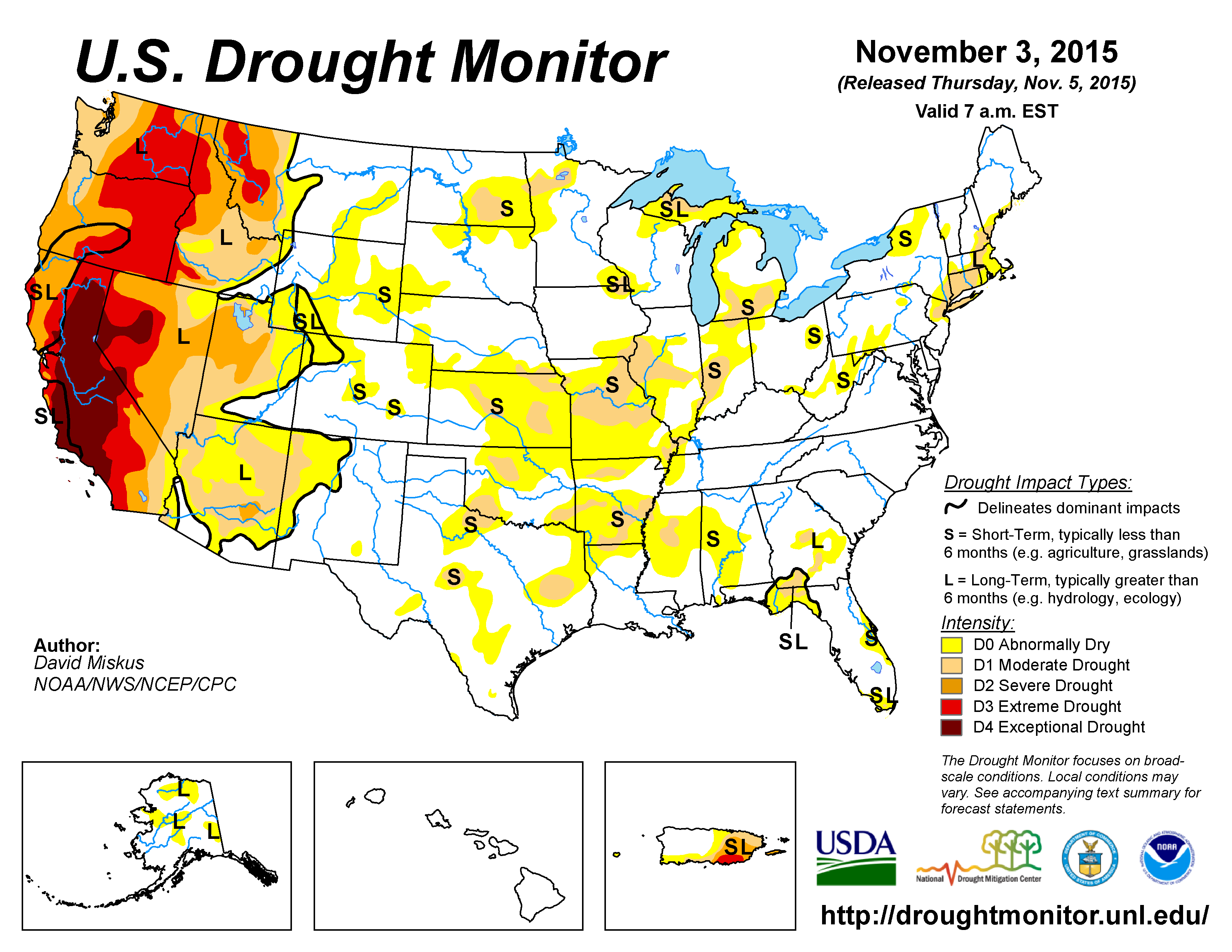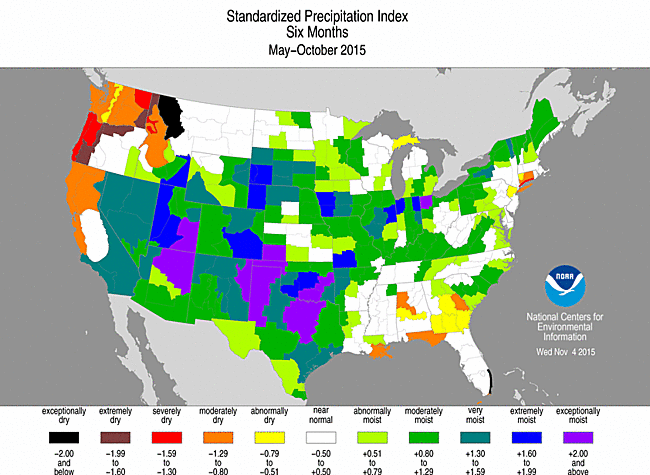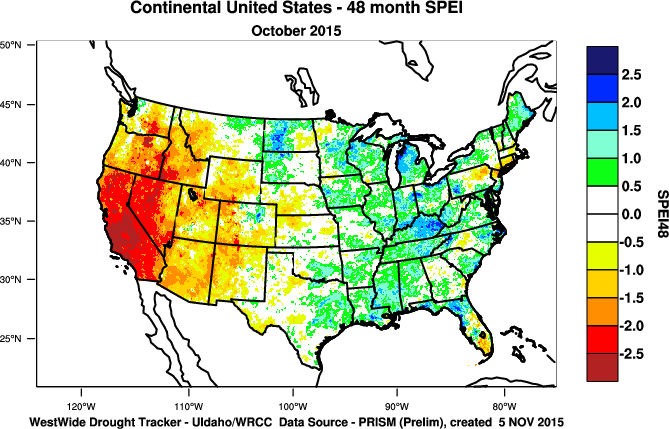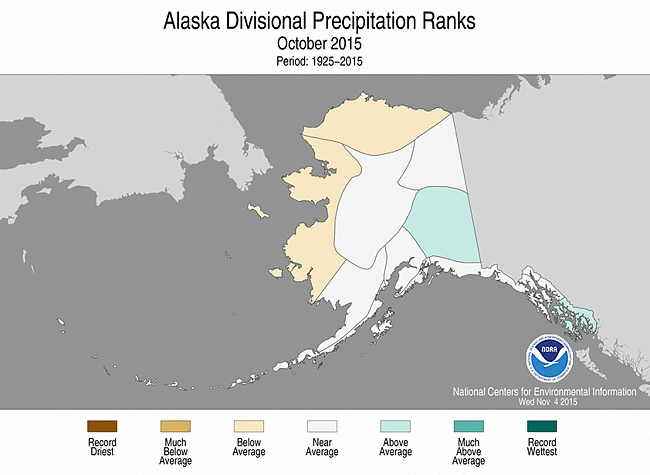|
Contents Of This Report: |
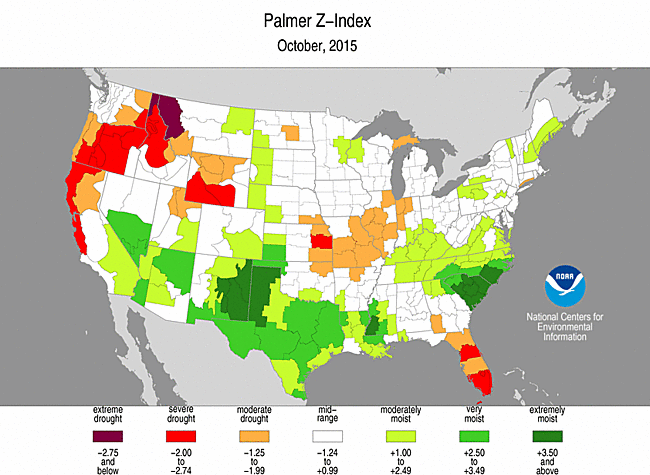
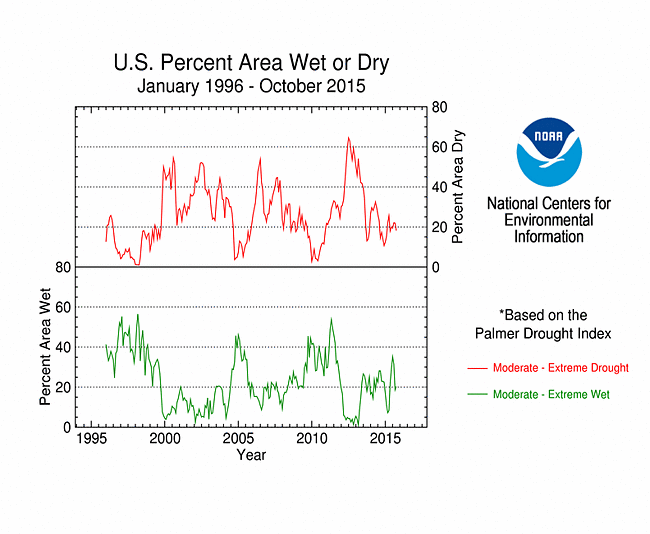
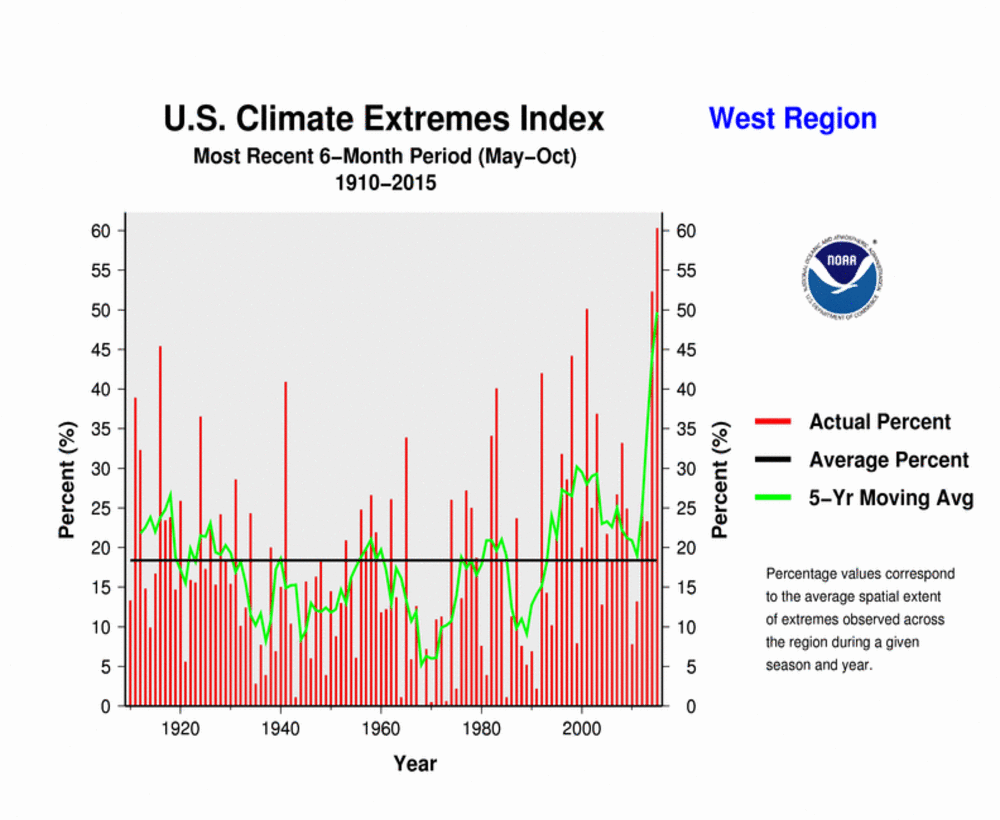
|
Please note that the values presented in this report are based on preliminary data. They will change when the final data are processed, but will not be replaced on these pages.
National Drought Overview
|
|
[top]
Detailed Drought Discussion
Overview
The weather and climate of October 2015 were influenced by a strong El Niño and a vigorous upper-level circulation, which directed numerous weather systems across the CONUS, some of which were enhanced by tropical moisture. These low pressure systems and fronts brought above-normal precipitation to much of the Southwest and Southern Plains, Lower Mississippi Valley, and Carolinas, and parts of the Tennessee Valley to Northeast and Northern High Plains. Drier-than-normal weather dominated the West Coast and much of the Central Plains to Great Lakes, and parts of the Southeast. The North Pacific and North Atlantic subtropical high pressure centers, and ridging in the jet stream, helped keep monthly temperatures warmer than normal across Alaska and most of the CONUS. The heavy tropical rains reduced drought in the Southern Plains to Lower Mississippi Valley and Carolinas. Drought also contracted slightly in parts of the Northeast and West, and above-normal precipitation across parts of Alaska and Puerto Rico reduced drought in those areas. The drier- and warmer-than-normal weather prompted expansion of drought in parts of the Central and Northern Plains to Great Lakes. When integrated across the CONUS, October 2015 ranked as the 20th wettest October in the 1895-2015 record, with the national drought footprint shrinking to 21.9 percent of the U.S. (26.2 percent of the CONUS). According to the Palmer Drought Index, which goes back to the beginning of the 20th century, about 18.2 percent of the CONUS was in moderate to extreme drought at the end of October, a decrease of about 3.7 percent compared to last month.
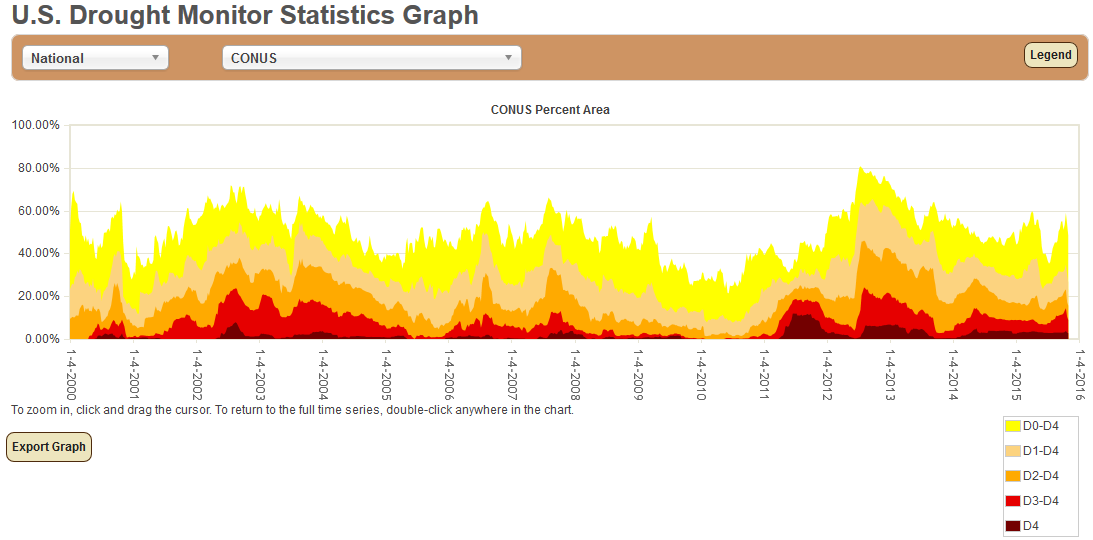
Percent area of the CONUS in moderate to exceptional drought, January 4, 2000 to present, based on the U.S. Drought Monitor.
Palmer Drought Index
The Palmer drought indices measure the balance between moisture demand (evapotranspiration driven by temperature) and moisture supply (precipitation). The Palmer Z Index depicts moisture conditions for the current month, while the Palmer Hydrological Drought Index (PHDI) and Palmer Drought Severity Index (PDSI) depict the current month's cumulative moisture conditions integrated over the last several months. While both the PDSI and PHDI indices show long-term moisture conditions, the PDSI depicts meteorological drought while the PHDI depicts hydrological drought. The PDSI map shows less severe and extensive drought in parts of the West than the PHDI map because the meteorological conditions that produce drought and wet spell conditions are not as long-lasting as the hydrological impacts.
 |
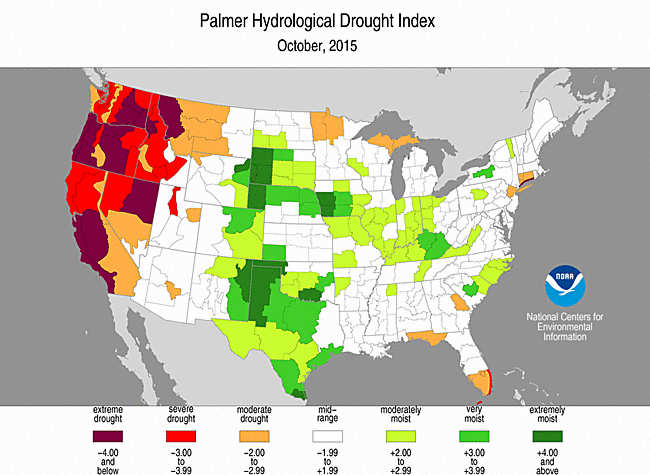 |
Used together, the Palmer Z Index and PHDI maps show that short-term dry conditions occurred over the Central Plains to Great Lakes, resulting in decreasing long-term wet conditions in October compared to September. Short-term dry conditions resulted in the development of long-term drought in southern Florida. Short-term dry conditions in the Northwest intensified the long-term drought. Wet short-term conditions from southern California to the Lower Mississippi Valley reduced long-term drought conditions, or expanded long-term wet conditions, compared to last month. Short-term wet conditions in the Carolinas eliminated the long-term drought conditions.
Standardized Precipitation Index
The Standardized Precipitation Index (SPI) measures moisture supply. The SPI maps here show the spatial extent of anomalously wet and dry areas at time scales ranging from 1 month to 24 months.
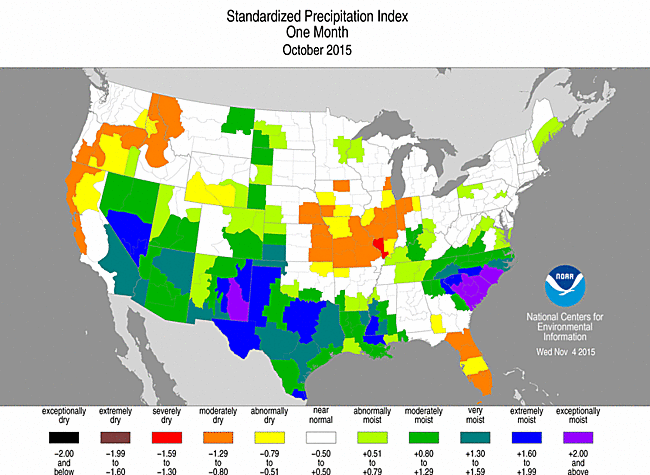 |
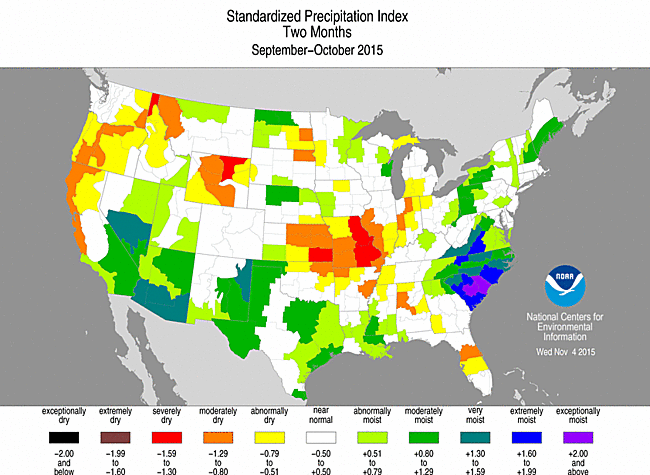 |
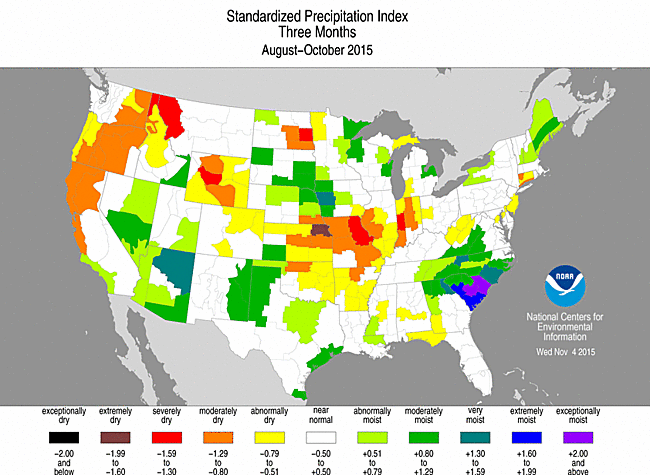 |
The SPI maps illustrate how moisture conditions have varied considerably through time and space over the last two years. Dryness in the Central Plains to Ohio Valley is evident on the 1- to 3-month SPI maps, but wetness dominates at the 6- to 24-month time scales. The Pacific Northwest and Far West are dominated by dryness at all time scales. Parts of Florida are dry at all time scales. In southern New England, the 1- and 2-month time scales show near-normal conditions, but dryness is evident at the 3- to 24-month time scales. The Southwest to Texas is dominated by near-normal to wet conditions at all time scales. Parts of the Southeast are dry at 1 to 12 months, and parts of the northern Great Lakes are dry at the 2- to 9-month time scales.
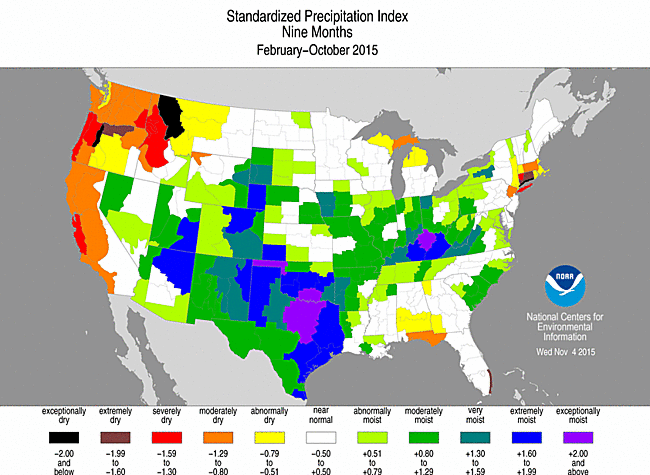 |
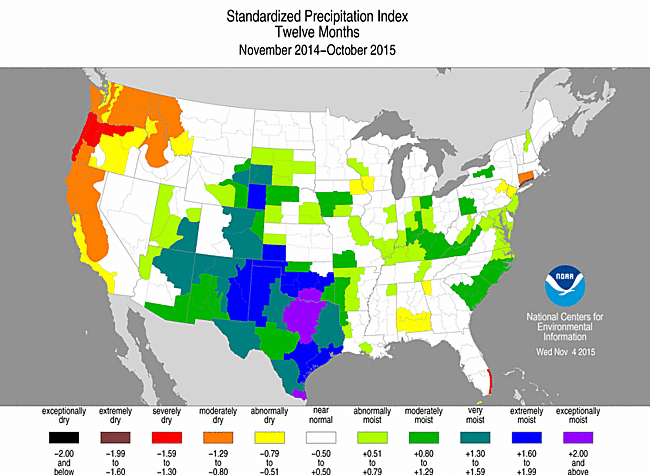 |
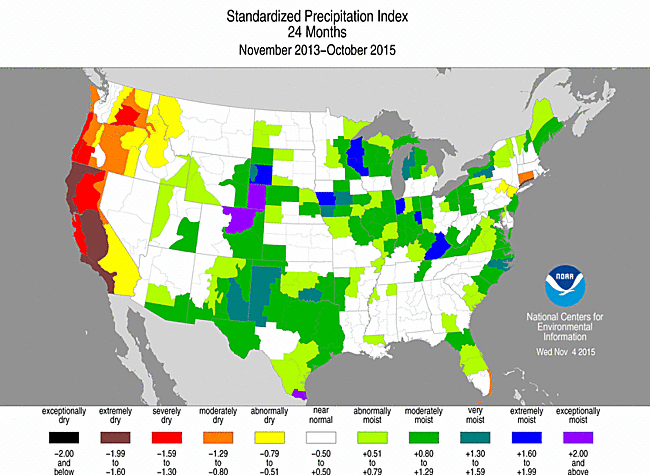 |
Standardized Precipitation Evapotranspiration Index
The SPI measures water supply (precipitation), while the SPEI (Standardized Precipitation Evapotranspiration Index) measures the combination of water supply (precipitation) and water demand (evapotranspiration as computed from temperature). Warmer temperatures tend to increase evapotranspiration, which generally makes droughts more intense.
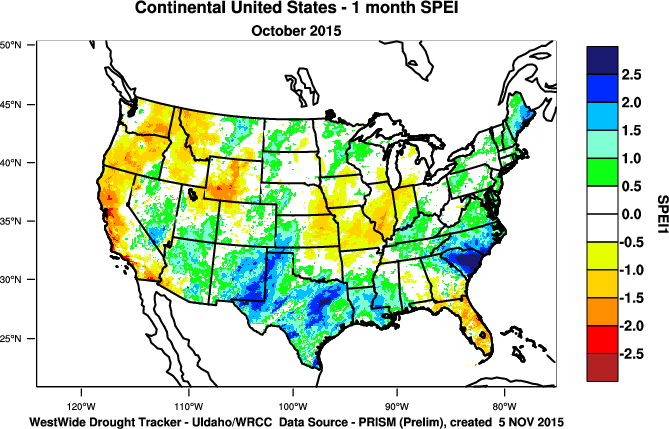 |
 |
During October 2015, temperatures were above normal across most of the CONUS, and much above normal across the West. The warmer-than-normal temperatures amplified the dry conditions in the West when the 1-month SPEI is compared to the SPI. The combination of heat and dryness of the last several months has been so severe that Washington has had the most extreme SPEI in the 1895-2015 record at several time scales this year (5, 6, 7, 8, 9, 10, 11 months) as well as Oregon (8, 9, 10 months).
 |
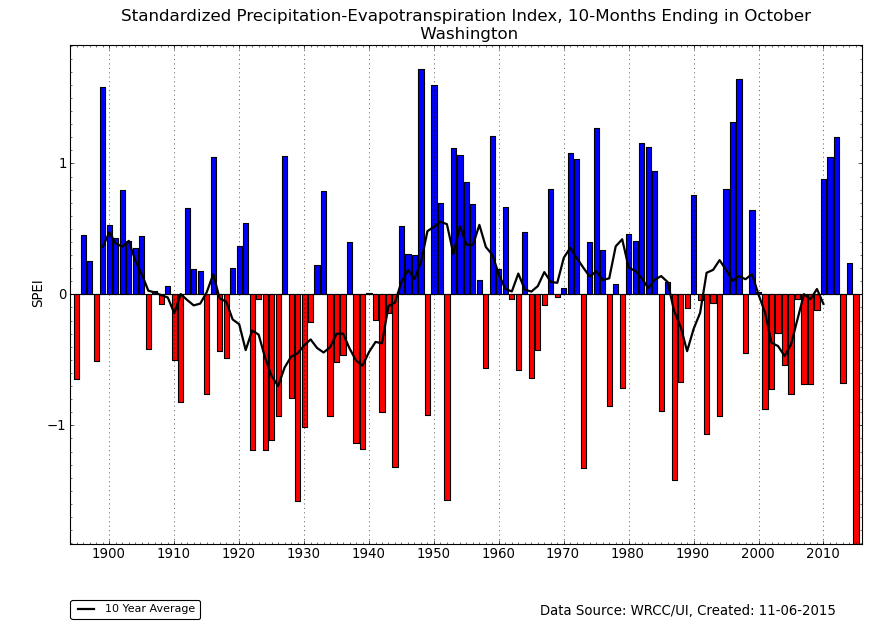 |
The persistent above-normal temperatures in the West have resulted in more severe SPEI values, compared to the SPI, for much of the last six years (SPEI maps for the last 12, 24, 36, 48, 60, 72 months) (SPI maps for the last 12, 24, 36, 48, 60, 72 months). The excessive heat has exacerbated drought conditions.
This is especially the case in California, where temperatures have been record warm for the last 12 months and well above average for each of the last four years. In fact, the November-October temperature for 2013-2014 was record warm up to that point, and this year (November 2014-October 2015) far exceeded that record value, causing the 24-month temperature to reach unprecedented values. The state has had the most severe 24-, 36-, 48-, 60-, and 72-month SPEI in the 1895-2015 record. The 12-month SPEI for 2015 ranks second most extreme behind last year's value. Even without the heat, the last four years have been the driest on record for California, according to the 48-month SPI. The 36-month SPI ranks as the second driest after last year's value.
 |
 |
Regional Discussion
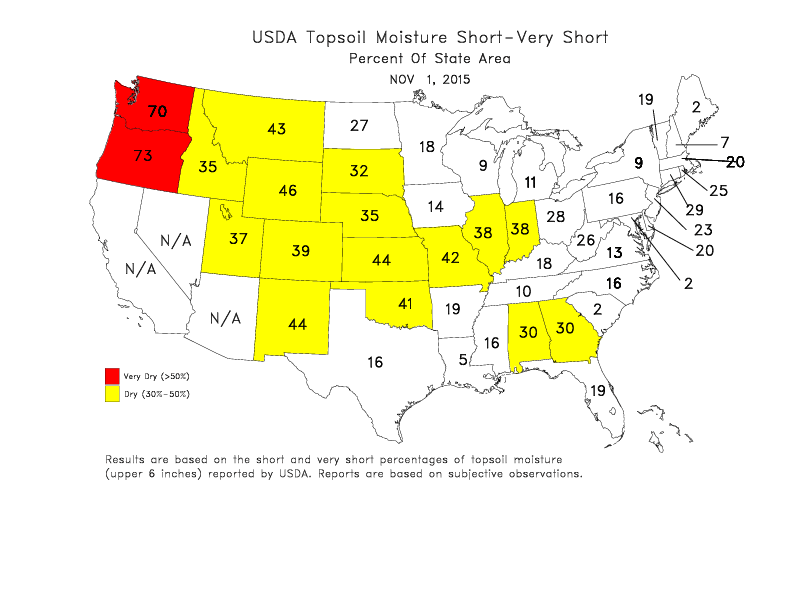 |
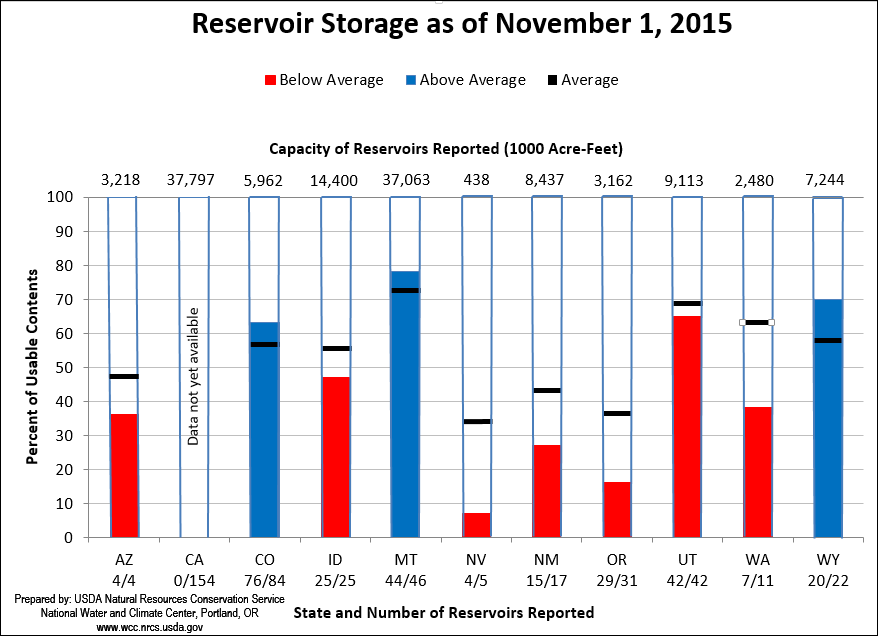 |
CONUS Agricultural & Hydrological Impacts:
Drought conditions were reflected in numerous agricultural, hydrological, and other meteorological indicators, both observed and modeled. According to November 1st U.S. Department of Agriculture (USDA) reports, only 12 percent of the winter wheat crop was rated in poor to very poor condition. As of November 3rd, 18 percent of the nation's hay, 18 percent of the cattle inventory, 22 percent of the winter wheat production, 13 percent of soybean production, and 11 percent of corn production were in drought. These are decreases for hay and cattle but increases for soybean and corn, compared to a month ago. But 30 percent of the nation's topsoil and 35 percent of the subsoil were short to very short of moisture (dry to very dry), which are decreases compared to the end of September. Conditions varied considerably from state to state.
Drought conditions at the end of the month, as depicted on the November 3rd USDM map, included the following CONUS core drought and abnormally dry areas:
- Moderate (D1) to severe (D2) drought covered a large part of the western U.S., with extreme (D3) to exceptional (D4) drought extending from California and Nevada into the Pacific Northwest and Northern Rockies. —
- Parts of the Pacific Northwest, Great Basin, and Southwest were wetter than normal during October, and some of the precipitation fell as snow, but most of the region still had a below-normal snowpack. The drought continued to be reflected in low streamflows, dry soils, lack of rain days and long runs of consecutive dry days, depleted groundwater, increased evaporative drying, continued stressed vegetation, and depleted reservoirs, especially in California. The USDA estimated that 95 percent of the topsoil in California, 73 percent in Oregon, 70 percent in Washington, and 55 percent in Nevada was short or very short of moisture. Subsoil moisture conditions were just as dire with 85 percent short or very short in California, 84 percent in Oregon, 70 percent in Nevada, 62 percent in Washington, and 51 percent in Utah. Several large wildfires, which had become widespread by the middle of the month, were largely extinguished by the end of the month as beneficial rains fell during the last couple weeks (weeks 1, 2, 3, 4, 5, ).
- Pockets of abnormally dry to moderate drought conditions expanded in parts of the Midwest and Central to Northern Plains under drier- and warmer-than-normal weather. —
- Drought conditions were reflected in increased evaporative drying and resulting stress on vegetation, drying soils, stressed groundwater supplies, areas with few rain days and long runs of consecutive dry days, and low streamflows. The USDA estimated that more than 40 percent of the topsoil was rated short or very short of moisture in Kansas (44 percent) and Missouri (42) as of November 1st, with more than 30 percent so rated in Illinois (38), Indiana (38), Nebraska (35), and South Dakota (32). Subsoil moisture conditions were short or very short in more than 40 percent of Kansas (47 percent), Missouri (46), Indiana (45), and Illinois (43), and more than 30 percent of Nebraska (35), South Dakota (35), Ohio (32), and North Dakota (31).
- Abnormally dry to moderate drought conditions continued in parts of the Northeast. —
- Like other parts of the country, drought conditions were reflected in stressed vegetation, low groundwater supplies, and low streamflows, especially in southern New England.
- Pockets of abnormally dry to moderate drought conditions remained in the Southern Plains to Southeast, although its extent was significantly reduced. —
- Heavy rains at the beginning of the month in the Southeast, and at the end of the month in the Southern Plains to Lower Mississippi Valley, eliminated severe to exceptional drought and greatly reduced the areas of moderate drought. The recovery in the Southern Plains and Lower Mississippi Valley can be seen in the improvement of the Crop Moisture Index as the month wore on (weeks 1, 2, 3, 4, 5). Vegetation, groundwater, and soil moisture conditions improved in the Southern Plains but continued to be stressed in parts of the Southeast. Arkansas, Oklahoma, and parts of Florida continued to have low soil moisture levels as well, with the USDA reporting topsoil moisture conditions short or very short in 41 percent of Oklahoma and 30 percent of Alabama and Georgia at the end of the month. Subsoil moisture was still short or very short across 53 percent of Oklahoma, 41 percent of Arkansas, and 31 percent of Georgia.
Hawaii: The precipitation anomaly pattern for October 2015 was mixed across Hawaii. Precipitation during the last several months has resulted in a wet pattern for the last 2, 3, 4, 6, and 7 months for most stations. Dryness was evident for some stations at the 10 and 24 month time scales, and for most stations at the 12 and 36 month time scales. There was no drought or abnormal dryness on the November 3rd USDM map.
Alaska: The reporting stations in Alaska had a mixed precipitation anomaly pattern during October and the last two months. The October climate division precipitation anomaly pattern was drier than normal in the north and west, and wetter than normal in the southeast. The pattern was predominantly wetter than normal for the last 3 to 6 months, both at the climate division scale and for the station reports (last 3, 4, 6, 7, 10 months). The pattern became mixed again at longer time scales (last 10 to 12 months for the climate divisions and last 12, 24, and 36 months for the station reports). The warmer-than-normal October temperature anomaly pattern held for most of the last year based on both the climate division (last 1, 3, 6, 10, 12 months) and station (last 1, 2, 3, 10, 12 months) analyses. Moderate drought disappeared, and abnormal dryness shrank to 22.8 percent of the state, on the November 3rd USDM map.
Puerto Rico: Beneficial rains fell across parts of Puerto Rico this month, resulting in a strip of above-normal precipitation across the west coast and along the middle of the island for October. At the longer time scales, the wetter-than-normal area shrank and moved more to the west end of the island, while drier-than-normal anomalies dominated the southern, northern, and eastern areas (last 2, 3, 6, 10 months). On the November 3rd USDM map, abnormal dryness and drought shrank to about 59.0 percent of Puerto Rico, with moderate to extreme drought contracting to 41.3 percent of the island. This included 6.5 percent in the extreme drought category.
CONUS State Precipitation Ranks:
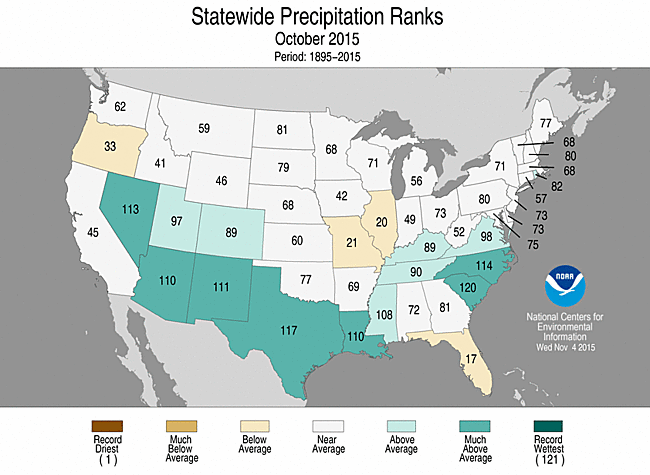 |
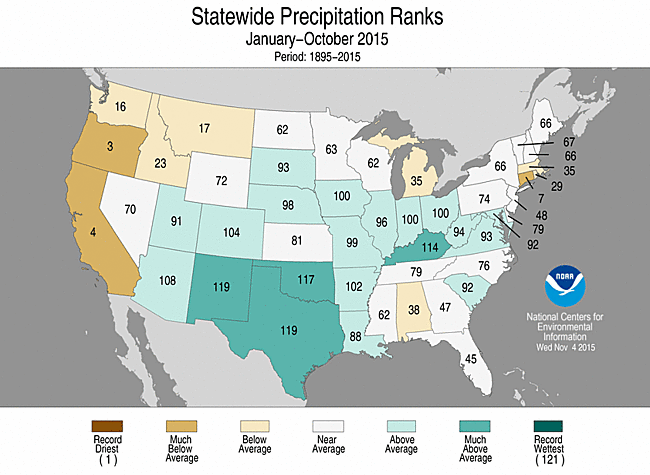
|
The October precipitation anomaly pattern of dryness in the central CONUS, Far West, and Southeast was reflected in the state ranks where Oregon, Missouri, Illinois, and Florida ranked in the driest third of the historical record. The rest of the Lower 48 states were wet (Southwest to Lower Mississippi Valley and Mid-Atlantic) or near average (rest of CONUS). For the last three months, the dry anomaly pattern in the Far West, central CONUS, and parts of the East was manifested in August-October state ranks in the driest third of the historical record for states in these areas, but no state ranked driest or in the top ten driest categories. The last six months were predominantly wetter than normal, with only five states (three in the Northwest, plus Florida and Connecticut) ranking in the driest third of the historical record for May-October.
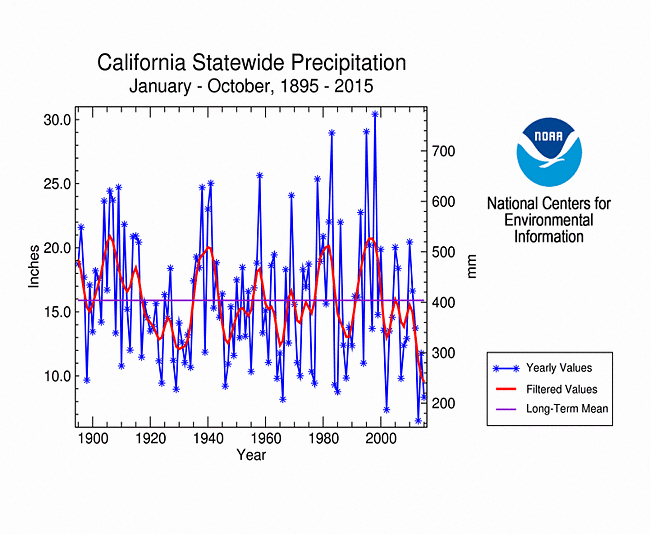 |
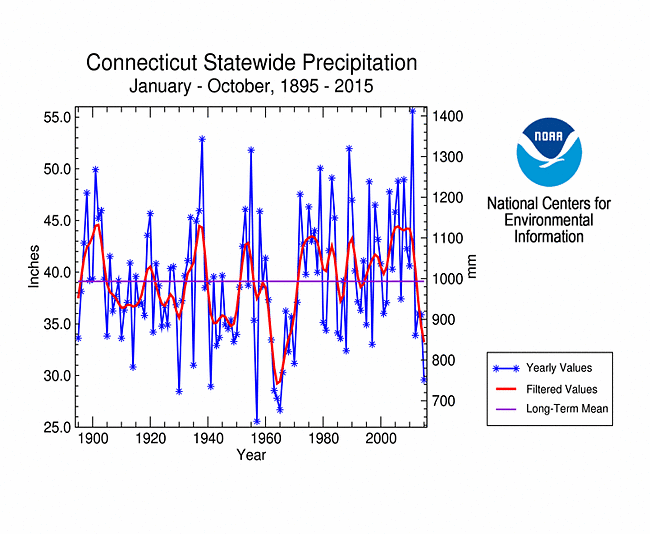
|
It isn't until the year-to-date that dryness is so severe it ranks states in the top ten driest category. Three states fell in this category for January-October 2015: Oregon (third driest year-to-date), California (fourth driest), and Connecticut (seventh driest). For both California and Connecticut, each of the last four year-to-dates has been drier than the long-term average. Seven other states (in the Northwest, Great Lakes, Southeast, and New England) ranked in the driest third of the historical record for January-October.
The last twelve months were drier than normal in the Far West, southern New England, and parts of the Southeast, Midwest, and Central to Northern Plains. Connecticut had the tenth driest November-October in the 1895-2015 record, and six other states ranked in the driest third of the historical record.
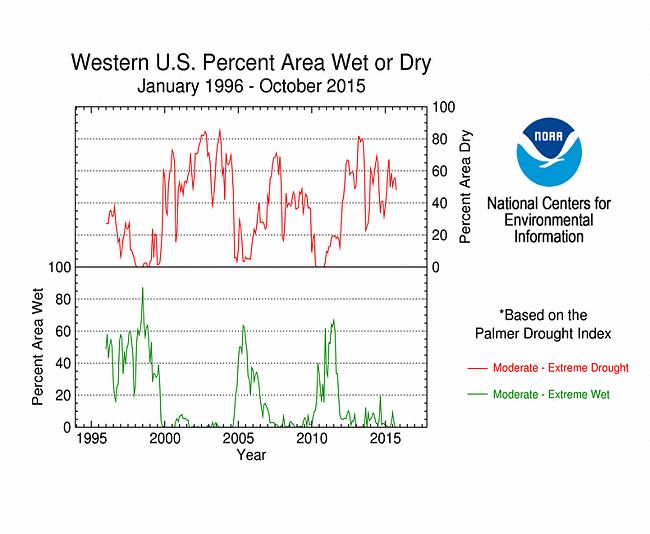
|

|
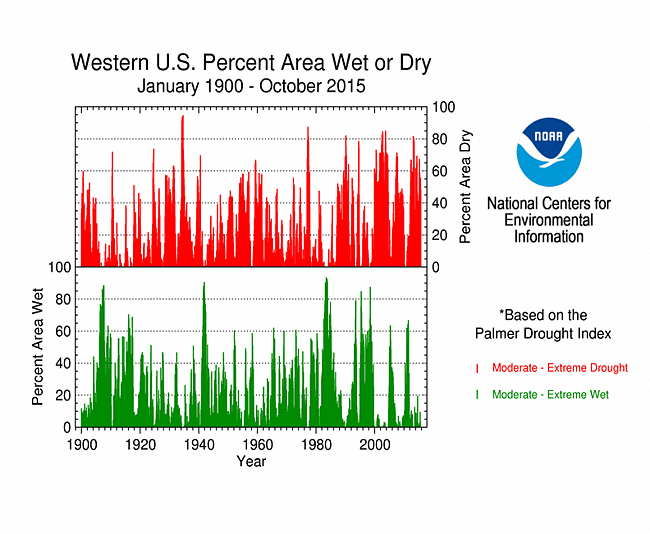
Percent area of the Western U.S. in moderate to extreme drought, January 1900 to present, based on the Palmer Drought Index.
Dry weather has dominated the West for much of the last four years, resulting in significant hydrological (low lake, reservoir, and stream levels) and agricultural impacts. According to the USDM, 54.5 percent of the West was experiencing moderate to exceptional drought at the end of October, which is a little less than the previous month. The Palmer Drought Index percent area statistic for the West was 48.2 percent, which is a drop of about 7 percent compared to the previous month.
Except for an occasional interruption, the dryness has been accompanied by unusually and persistently hotter-than-normal weather. October 2015 saw widespread warmth across the West with Washington having the warmest October on record and all other western states ranking in the top ten warmest category. Integrated across the West (Rockies to West Coast), October 2015 ranked as the second warmest October in the 1895-2015 record, behind October 1988. For the last twelve months, Arizona, California, Nevada, Oregon, Utah, and Washington had the warmest November-October on record, with the remaining western states ranking in the top ten warmest category. This persistent and widespread extreme warmth gave the West the warmest November-October on record. The West has seen a generally steady increase in the persistent and unusual warmth during the last three decades.
Unusually warm temperatures increase evapotranspiration and make drought conditions worse. The PHDI for the West shows the effect of dry and hot weather integrated across area. Hot and dry weather that occurs across a large area will result in more extreme PHDI values. By this measure, the worst individual drought of the last century occurred during 1976-77; the 1930s were also a period of persistent bad drought. It also shows that the 2014-15 drought is as extreme as the worst drought years of the 1930s, and that the last 15 years have been a period of persistent extreme drought for the West.
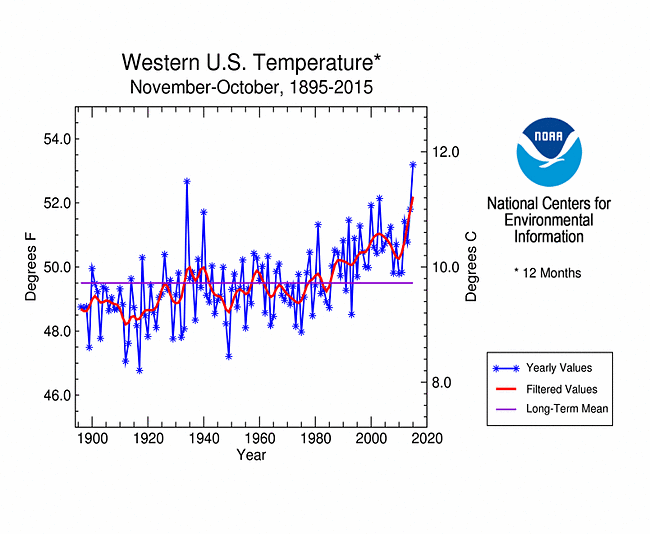
|
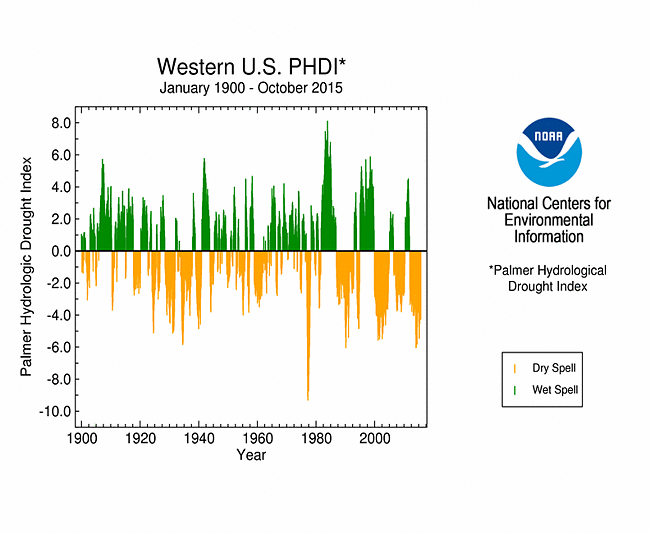
|
The combination of persistent extreme warmth and extreme dryness across the West has resulted in a record to near-record Climate Extremes Index (CEI). The CEI aggregates temperature and precipitation extremes across space and time and is a good measure for this aspect of climate. The West and Northwest CEI regions both had the second most extreme October CEI in the 1910-2015 record due to extreme warm maximum and minimum temperatures and prolonged extreme long-term drought. The Northwest also had an unusual number of days with precipitation for this time of year. Due to the persistence of the widespread and unusual warmth and long-term dryness, interspersed with bouts of heavy 1-day precipitation events, these two regions have had the most extreme CEI for August-October (West, Northwest), May-October (West, Northwest), January-October (West, Northwest), and November-October (West, Northwest).
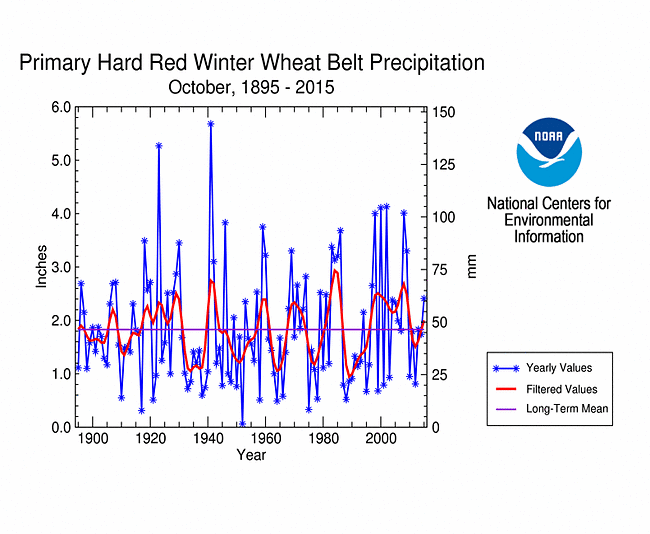 |
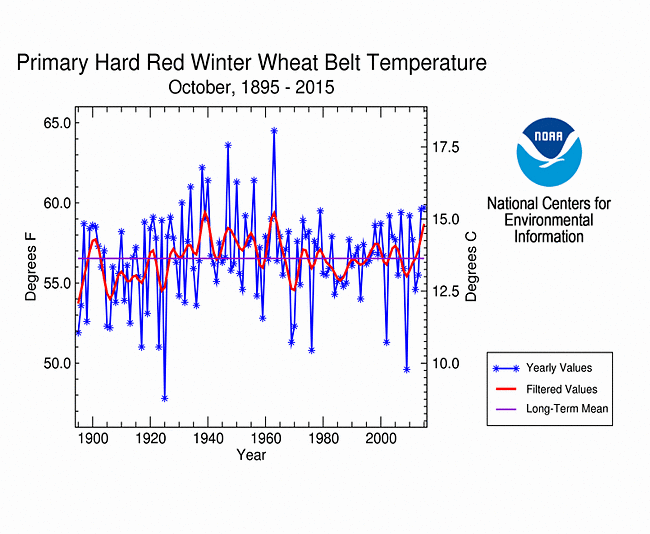 |
October marks the beginning of the growing season for the Primary Hard Red Winter Wheat agricultural belt. The region was generally wetter- and warmer-than-normal for the month, with October 2015 ranking as the 33rd wettest and ninth warmest October in the 1895-2015 record, regionwide.
NOAA Regional Climate Centers:
A more detailed drought discussion, provided by the NOAA Regional Climate Centers and others, can be found below.
West
As described by the High Plains Regional Climate Center, warm weather continued this month for the High Plains and precipitation varied across the region, with some locations receiving little to no precipitation and others receiving greater than 150 percent of normal precipitation. Dry areas included eastern Kansas, eastern Nebraska, north-central South Dakota, east-central North Dakota, and a swath running from the southwest to the northeast through central Wyoming. These areas received, at most, 50 percent of normal precipitation. In some of these areas, the dryness was not isolated to October and drought conditions emerged.
A continuation of dry conditions in the eastern part of the High Plains region has led to changes in the USDM over the past month. The total area in drought (D1-D4) in the region increased from just under one percent to about 4 percent. Moderate drought conditions (D1) developed in portions of central and eastern North Dakota, eastern Kansas, and far southeastern Nebraska. Over the past three months, these areas have received less than 50 percent of normal precipitation. This has translated into deficits of 2.00-6.00 inches (51-152 mm) to the north and 4.00-8.00 inches (102-203 mm) in the south. The area of D1 that emerged in north-central Kansas last month expanded slightly on the southern end and improved to abnormally dry conditions (D0) in the middle, dividing the area into two. By the end of the month, the total area in drought in Kansas had increased to just over 14 percent. D0 also expanded this month and now encompasses over 40 percent of the region. When D0 develops, it highlights areas that should be monitored for possible drought development. Areas with D0 expansion included central and eastern Kansas, northwestern Colorado, southwestern Wyoming, southern Nebraska, northern South Dakota, and eastern North Dakota.
The ongoing dry conditions in Kansas have already impacted winter wheat. According to Kansas State extension, the dryness in central Kansas has been problematic for winter wheat emergence. Producers may need to replant in these areas of uneven and poor emergence.
As explained by the Southern Regional Climate Center, October was a warmer than normal month for all six states in the Southern region, but precipitation varied spatially from extremely wet to extremely dry. Though all six states in the region experienced a wetter than normal month, conditions in northern Arkansas and central/eastern Oklahoma were quite dry with most stations reporting less than 70 percent of normal rainfall. In the northern counties of Arkansas and Oklahoma, many stations reported less than half the monthly expected precipitation. Heavy precipitation near the end of the month helped alleviate drought conditions across the region. As of November 3, 2015, only 7.15 percent of the Southern region was classified in moderate drought. All severe drought and beyond has been removed.
As summarized by the Midwest Regional Climate Center, temperatures in the Midwest were slightly above normal and large parts of the region were very dry in October. Rainfall totals were less than 50 percent of normal from southwest Iowa, through most of Missouri and Illinois, and into southeast Wisconsin, northwest Indiana, and southwest Michigan. The driest area was along the Mississippi River south of St. Louis with totals less than 25 percent of normal. Missouri had the driest September-October period since 1963 statewide with some locations in the state setting record lows for October or September-October. Drought expanded in the region due to the dry conditions. As of the September 29th USDM, only three Midwest states had small areas of drought, covering just 1 percent of the region. By the October 27th version, just before the rains from Patricia, drought had expanded to every Midwest state except Ohio and covered 16 percent of the region. Abnormally dry conditions also expanded from 20 to 49 percent of the region in the same period. Harvest was nearing an end for corn and soybeans across the Midwest as October came to a close. All nine states were at or ahead of their 5-year averages, with many exceeding 90 percent of the crop harvested. Yields were particularly good in the northern parts of the region. Further south yields were lowered due to wet periods earlier in the growing season.
As noted by the Southeast Regional Climate Center, temperatures were near average across much of the Southeast region during October and precipitation was highly variable. The driest locations were found across much of Florida and southern Georgia, where monthly precipitation totals were between 5 and 50 percent of normal. The wettest locations were found across southern Alabama, northern Georgia, the Carolinas, and southwestern Virginia. Precipitation was highly variable across Puerto Rico and the U.S. Virgin Islands. While San Juan, PR observed its fifth driest October on record with only 1.77 inches (45 mm) of precipitation, Aibonito, PR (located about 25 miles southwest of San Juan) recorded 13.92 inches (354 mm) of precipitation during the month. Mean temperatures were well above average in Puerto Rico and the U.S. Virgin Islands. Three reporting stations in Puerto Rico, including San Juan (1899-2015), Guayama (1914-2015), and Juncos (1931-2015), observed their warmest October mean temperatures on record.
Drought conditions improved significantly across much of the Southeast region during October. The percentage of the region under drought-free conditions (less than D1) increased from 88 percent on September 29th to 94 percent on October 27th. Following the historic rainfall during the first week of the month, moderate-to-severe (D1 and D2) drought conditions were completely ameliorated across the Carolinas. Moderate drought conditions were eliminated over southern Alabama in the vicinity of Mobile; however, a new area of moderate drought developed over west-central Alabama in response to below-normal precipitation. Beneficial rainfall over eastern Puerto Rico resulted in a 12 percent decrease of severe-to-extreme (D2 and D3) drought coverage by the end of the month. Seasonal yields for several fields crops, including cotton, peanuts, and soybeans, were substantially reduced across the Carolinas due to excessive rainfall during early October.
As explained by the Northeast Regional Climate Center, the Northeast experienced near-normal temperatures and precipitation in October. At the start of October, 49 percent of the Northeast was abnormally dry, with another 9 percent of the region experiencing moderate drought. Conditions improved through mid-month, but remained steady for the rest of the month. In the October 29 USDM, 21 percent of the Northeast was abnormally dry and 6 percent of the region was experiencing moderate drought.
As summarized by the Western Regional Climate Center, temperatures were well above normal throughout the West this month, and precipitation was above normal in much of the Great Basin and Southwest, while coastal areas generally saw below normal rainfall, which is not uncommon in this transition to the wet season. San Francisco, California saw no precipitation this month, which occurred in 12 other years in the station's 167-year record. Drought conditions held steady for California this month and improvements were seen in Arizona, New Mexico, the southern portions of Utah and Idaho, northern Montana, and northwest Washington, generally in association with October's areas of above-normal rainfall. Small areas of deteriorating drought conditions were observed along the western Colorado-Wyoming border, where precipitation was 50% of normal or less this month. California's Folsom Lake reached its lowest level in 20-plus years. This major reservoir was at just 17% of capacity and 31% of average level this month, the lowest since the 1987-1992 drought. The record low occurred in 1977.
Precipitation was highly variable across Alaska, with stations along the North Slope observing below normal precipitation and stations in the Interior and Southcentral regions ranging from less than 50% of normal to more than 150% of normal. In the Southeast, remnants of Tropical Storm Oho were entrained into a low-pressure system tracking towards Alaska, bringing copious rainfall to Ketchikan on October 7-9. Above normal temperatures were observed throughout Alaska, with the greatest departures in the Interior, Western, and Southcentral regions. To the southwest, above normal temperatures continued for some areas of Hawaii. Precipitation was variable across the state, with Lihue, Kauai in the far northwest observing its 2nd driest October on record at 0.36 in (9 mm), 9% of normal. Hilo, in the southeast, had its 6th wettest October on record with 15.84 in (402 mm), 162% of normal. Records for Lihue began in 1950 and records for Hilo in 1949.
Pacific Islands: According to reports from National Weather Service offices, the Pacific ENSO Applications Climate Center (PEAC), and partners, conditions varied across the Pacific Islands.
In the U.S. Affiliated Pacific Islands (maps — Micronesia, Marshall Islands, basinwide), October 2015 was wetter than normal at Guam, Saipan, and Kwajalein, and drier than normal at the rest of the primary stations.
Rainfall amounts were below the minimum thresholds (4 or 8 inches) required to meet most monthly water needs at stations in the Marshall Islands, Palau, and Micronesia. These included Jaluit, Koror, Yap, Ulithi, Woleai, Fananu, Chuuk, Lukonor, and Kosrae. Jaluit recorded 4.51 inches, marking the ninth out of the last eleven months that have been drier than 8 inches. Tamil reported 2.60 inches of rain, Maap 2.70 inches, Gilman 3.13 inches, Rumung 3.76 inches, and Fananu 3.90 inches. The 4- and 8-inch thresholds are important because, if monthly precipitation falls below the threshold, then drought becomes a concern. Below-normal rainfall is expected to continue for many of these stations as the strong El Niño persists.
Pago Pago measured 8.15 inches of rainfall during October. Even though this is greater than 8 inches and breaks a string of very dry months, it is still below normal for October.
As measured by percent of normal precipitation, Koror and Lukonor have been drier than normal in the short term (October and the last 3 months [August-October 2015]) as well as the long term (year to date [January-October 2015] and last 12 months [November 2014-October 2015]). Guam, Saipan, and Kwajalein were wetter than normal at all time scales. Kapingamarangi, Yap, and Pago Pago have been drier than normal in the short term but near to wetter than normal in the long term. Majuro, Chuuk, and Pohnpei were drier than normal for October but wetter than normal at the other three time scales. Kosrae was near normal for the last 3 months, but drier than normal at the other 3 time scales.
| Station Name | Nov 2014 | Dec 2014 | Jan 2015 | Feb 2015 | Mar 2015 | Apr 2015 | May 2015 | Jun 2015 | Jul 2015 | Aug 2015 | Sep 2015 | Oct 2015 | Nov- Oct |
|---|---|---|---|---|---|---|---|---|---|---|---|---|---|
| Chuuk | 66% | 57% | 142% | 134% | 209% | 104% | 89% | 172% | 54% | 155% | 188% | 53% | 111% |
| Guam NAS | 75% | 76% | 213% | 6% | 198% | 263% | 291% | 86% | 215% | 146% | 108% | 125% | 116% |
| Kapingamarangi | 140% | 116% | 229% | 131% | 62% | 87% | 173% | 161% | 54% | 162% | 112% | 63% | 107% |
| Koror | 54% | 118% | 64% | 83% | 69% | 74% | 33% | 107% | 27% | 73% | 143% | 53% | 68% |
| Kosrae | 68% | 86% | 116% | 114% | 91% | 92% | 84% | 143% | 108% | 138% | 115% | 63% | 85% |
| Kwajalein | 96% | 68% | 74% | 149% | 994% | 322% | 204% | 117% | 104% | 171% | 95% | 105% | 147% |
| Lukonor | 70% | 86% | 228% | 97% | 99% | 83% | 89% | 136% | 77% | 75% | 149% | 40% | 87% |
| Majuro | 66% | 67% | 106% | 63% | 329% | 162% | 171% | 57% | 87% | 207% | 96% | 83% | 116% |
| Pago Pago | 136% | 141% | 201% | 102% | 64% | 153% | 172% | 170% | 72% | 125% | 18% | 88% | 110% |
| Pohnpei | 108% | 104% | 78% | 100% | 138% | 119% | 219% | 108% | 138% | 199% | 124% | 78% | 126% |
| Saipan | 265% | 47% | 184% | 14% | 315% | 203% | 341% | 115% | 112% | 141% | 92% | 198% | 148% |
| Yap | 84% | 197% | 92% | 89% | 93% | 139% | 235% | 92% | 82% | 148% | 68% | 43% | 104% |
| Station Name | Nov 2014 | Dec 2014 | Jan 2015 | Feb 2015 | Mar 2015 | Apr 2015 | May 2015 | Jun 2015 | Jul 2015 | Aug 2015 | Sep 2015 | Oct 2015 | Nov- Oct |
|---|---|---|---|---|---|---|---|---|---|---|---|---|---|
| Chuuk | 6.99" | 6.46" | 14.32" | 9.68" | 17.37" | 13.03" | 10.08" | 20.03" | 6.45" | 19.91" | 22.07" | 6.09" | 152.48" |
| Guam NAS | 5.51" | 3.87" | 8.56" | 0.18" | 4.09" | 6.65" | 9.91" | 5.32" | 21.80" | 21.54" | 13.71" | 14.26" | 115.4" |
| Kapingamarangi | 13.02" | 11.37" | 20.91" | 12.19" | 7.05" | 11.82" | 20.84" | 22.14" | 7.71" | 13.14" | 11.08" | 5.13" | 156.4" |
| Koror | 6.12" | 13.14" | 6.48" | 7.07" | 5.11" | 5.42" | 3.96" | 18.66" | 4.98" | 9.90" | 16.88" | 6.24" | 103.96" |
| Kosrae | 9.38" | 13.80" | 19.28" | 14.73" | 14.57" | 16.12" | 14.89" | 20.90" | 16.17" | 19.69" | 16.36" | 6.90" | 182.79" |
| Kwajalein | 10.80" | 4.54" | 2.33" | 3.94" | 23.37" | 16.94" | 13.69" | 8.12" | 10.28" | 16.63" | 10.24" | 11.71" | 132.59" |
| Lukonor | 6.37" | 9.65" | 19.16" | 8.70" | 9.16" | 9.36" | 10.36" | 15.83" | 12.22" | 10.55" | 15.15" | 4.53" | 131.04" |
| Majuro | 8.85" | 7.68" | 8.24" | 4.32" | 21.65" | 15.23" | 17.27" | 6.31" | 9.72" | 24.24" | 10.72" | 10.52" | 144.75" |
| Pago Pago | 13.76" | 18.13" | 26.87" | 12.22" | 6.88" | 14.35" | 16.59" | 9.07" | 3.99" | 6.75" | 1.20" | 8.15" | 137.96" |
| Pohnpei | 15.97" | 16.67" | 10.24" | 9.58" | 18.14" | 21.94" | 43.68" | 16.03" | 21.31" | 28.33" | 15.59" | 11.86" | 229.34" |
| Saipan | 14.87" | 1.80" | 4.66" | 0.35" | 5.95" | 5.34" | 8.11" | 4.15" | 10.00" | 18.51" | 9.26" | 21.00" | 104" |
| Yap | 7.40" | 16.77" | 5.86" | 4.60" | 4.22" | 7.80" | 18.41" | 11.07" | 12.39" | 21.99" | 9.21" | 5.29" | 125.01" |
| Station Name | Nov 2014 | Dec 2014 | Jan 2015 | Feb 2015 | Mar 2015 | Apr 2015 | May 2015 | Jun 2015 | Jul 2015 | Aug 2015 | Sep 2015 | Oct 2015 | Nov- Oct |
|---|---|---|---|---|---|---|---|---|---|---|---|---|---|
| Chuuk | 10.61" | 11.25" | 10.10" | 7.25" | 8.32" | 12.47" | 11.30" | 11.66" | 11.98" | 12.86" | 11.71" | 11.51" | 136.77" |
| Guam NAS | 7.38" | 5.11" | 4.01" | 3.03" | 2.07" | 2.53" | 3.40" | 6.18" | 10.14" | 14.74" | 12.66" | 11.44" | 99.09" |
| Kapingamarangi | 9.27" | 9.84" | 9.15" | 9.27" | 11.43" | 13.64" | 12.08" | 13.78" | 14.15" | 8.13" | 9.93" | 8.19" | 145.85" |
| Koror | 11.39" | 11.16" | 10.18" | 8.56" | 7.44" | 7.32" | 11.83" | 17.48" | 18.53" | 13.50" | 11.77" | 11.84" | 152.90" |
| Kosrae | 13.83" | 16.11" | 16.67" | 12.93" | 16.06" | 17.51" | 17.75" | 14.64" | 14.91" | 14.22" | 14.22" | 10.94" | 213.87" |
| Kwajalein | 11.28" | 6.66" | 3.16" | 2.64" | 2.35" | 5.26" | 6.72" | 6.93" | 9.87" | 9.74" | 10.74" | 11.18" | 90.41" |
| Lukonor | 9.08" | 11.27" | 8.41" | 8.93" | 9.26" | 11.31" | 11.69" | 11.65" | 15.93" | 14.04" | 10.15" | 11.32" | 151.36" |
| Majuro | 13.44" | 11.39" | 7.74" | 6.88" | 6.58" | 9.42" | 10.11" | 11.01" | 11.17" | 11.69" | 11.17" | 12.73" | 125.25" |
| Pago Pago | 10.14" | 12.84" | 13.34" | 12.00" | 10.68" | 9.39" | 9.66" | 5.33" | 5.55" | 5.38" | 6.53" | 9.26" | 125.57" |
| Pohnpei | 14.83" | 16.08" | 13.18" | 9.55" | 13.17" | 18.41" | 19.96" | 14.81" | 15.43" | 14.26" | 12.55" | 15.27" | 182.36" |
| Saipan | 5.61" | 3.85" | 2.53" | 2.59" | 1.89" | 2.63" | 2.38" | 3.62" | 8.91" | 13.13" | 10.09" | 10.62" | 70.25" |
| Yap | 8.83" | 8.51" | 6.39" | 5.19" | 4.56" | 5.63" | 7.85" | 12.04" | 15.08" | 14.82" | 13.50" | 12.18" | 120.31" |
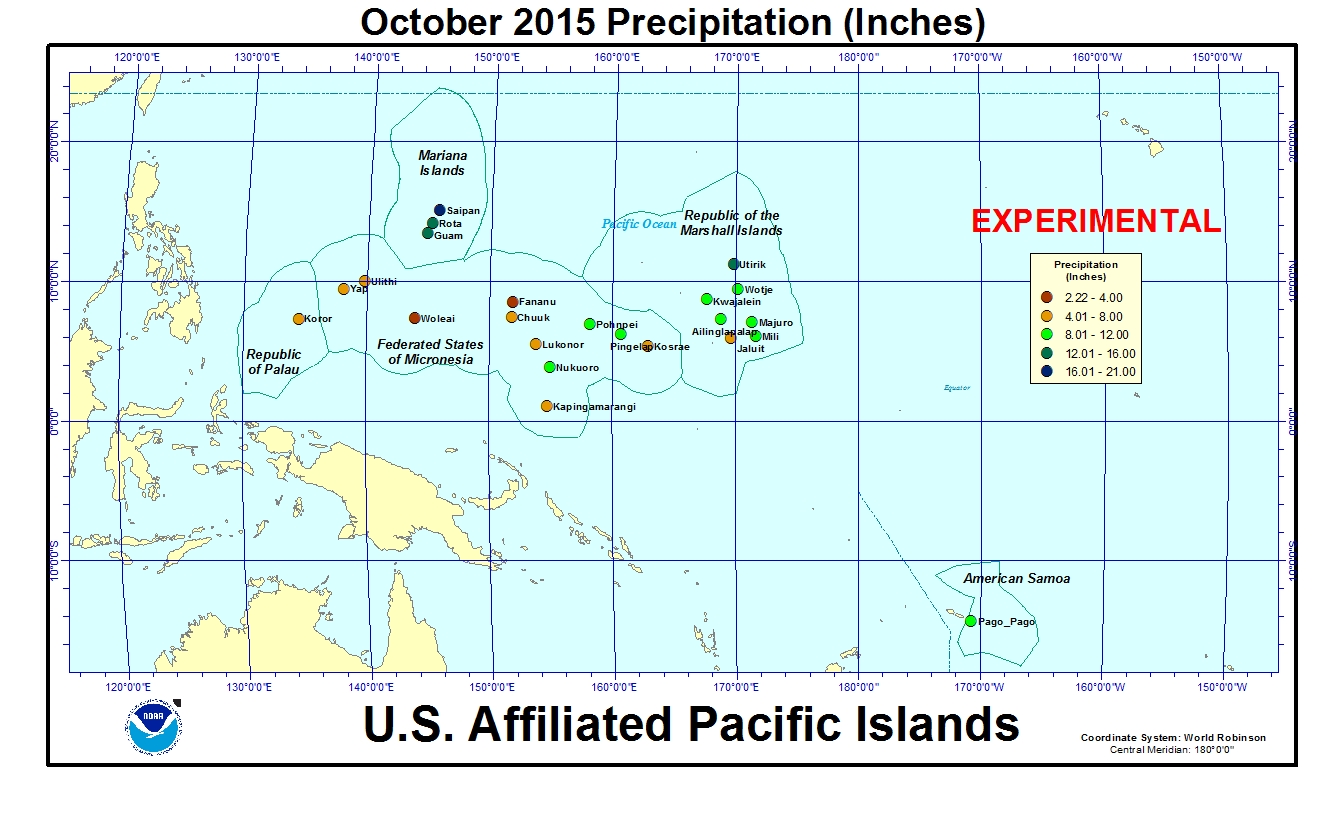

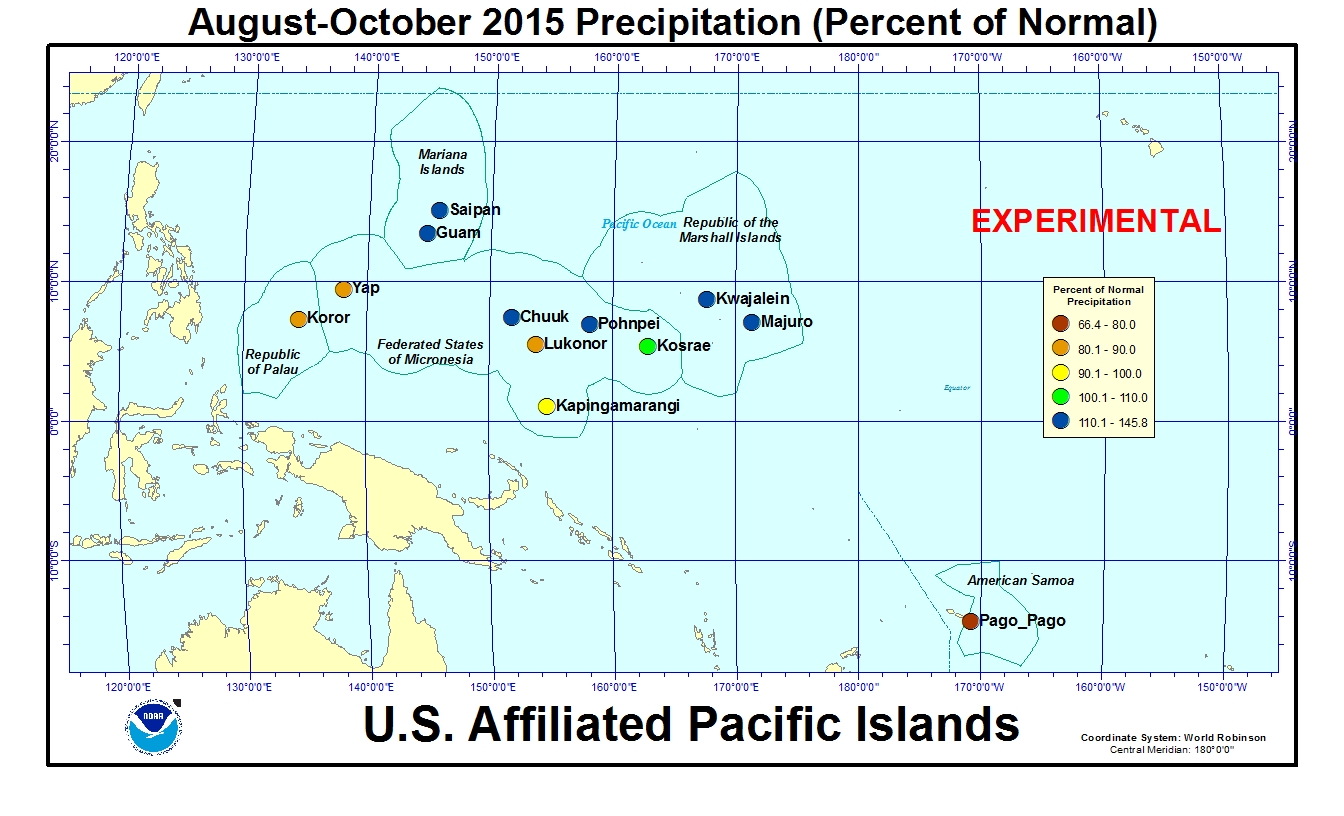
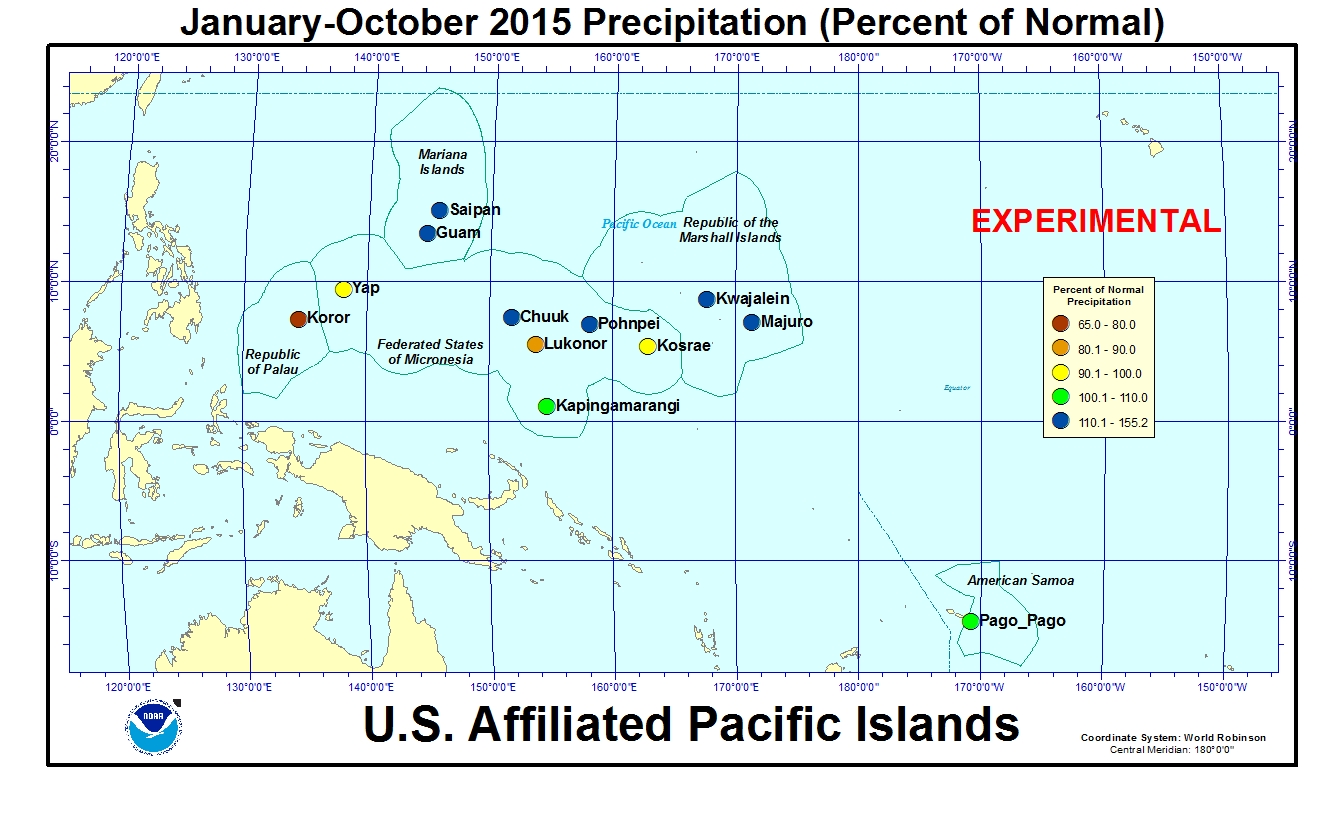
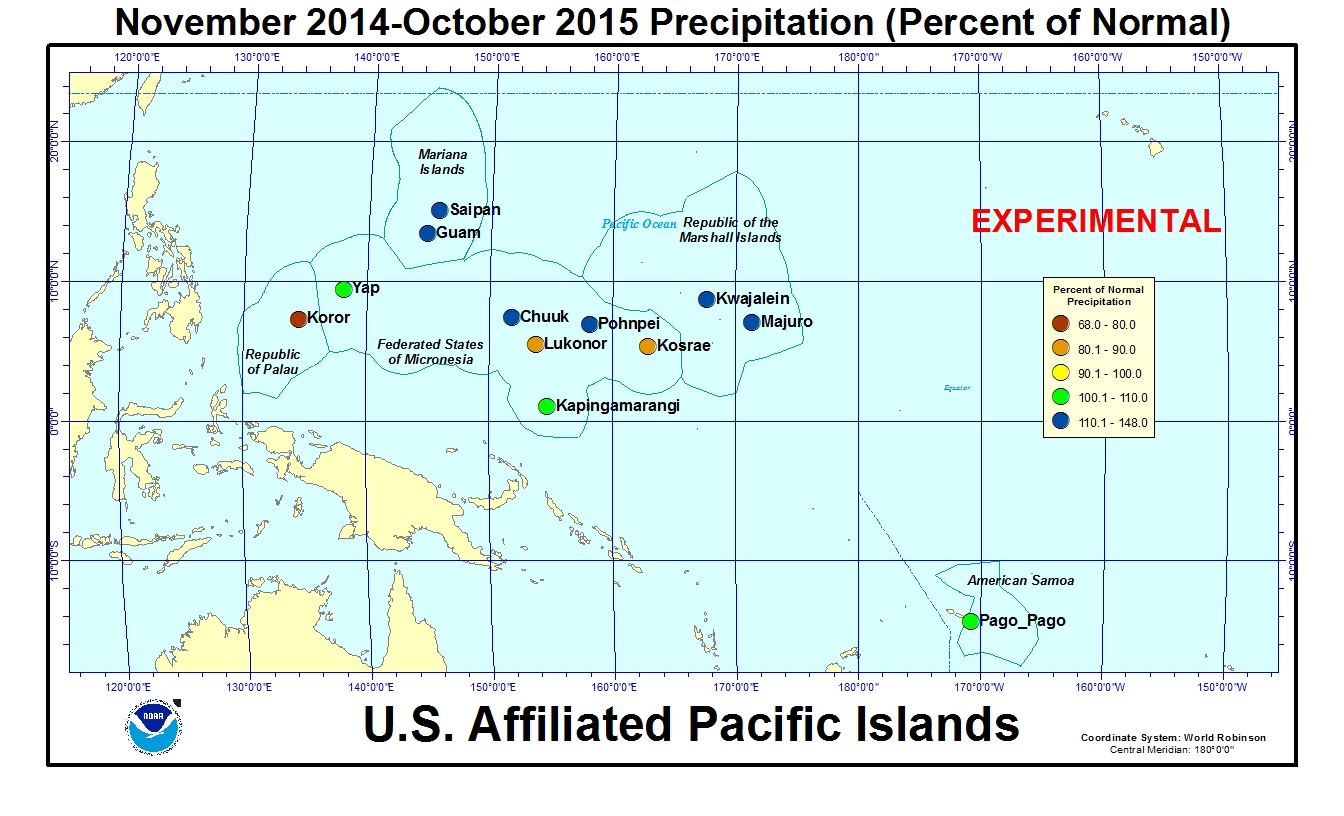

[top]
State/Regional/National Moisture Status
A detailed review of drought and moisture conditions is available for all contiguous U.S. states, the nine standard regions, and the nation (contiguous U.S.):
| northeast u. s. | east north central u. s. | central u. s. |
| southeast u. s. | west north central u. s. | south u. s. |
| southwest u. s. | northwest u. s. | west u. s. |
| Contiguous United States |
[top]
Contacts & Questions
 NOAA's National Centers for Environmental Information
NOAA's National Centers for Environmental Information
